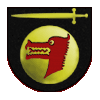Fighting
Fighting is both a sport and a martial art. I like to think that SCA fighting takes the best parts of both, and leaves the worst behind. SCA fighting is competative, but winning and losing are a matter of honor. A fighter only dies when he or she (we have lots of women fighters) determines that a hit has sufficient force to penetrate armor and either kil or disable the fighter.
You might ask, "If it's up to me to take my shots, then how would anybody know if I don't take shots?" The answer would be this: You may lie to one fighter, and you may lie to another fighter. But eventually, everyone will know you're a liar, and no one will believe you.
There used to be two kinds of fighters. They are Heavy, and Light. Heavies fought in close with hand to hand weapons - which is what I do. Lights fought at a distance, using, ranged weapons like bow and arrows, or javelines.
Now, there are only Heavy fighters and Heavy fighters who are also Missle Combatants. Missle combatants are expected to wear the same armor as a regular fighter and are expected to switch to hand-to-hand weapons or yield when an oppossing force closes in.
The armor we wear is very effective, and reduces blows that would kill, or severely injure a fighter (break bones) to a level of force that equates to somewhere between a rough pillow-fight and at worst, getting tackled in a football game. This does not mean that we don't get injured. It means that an injury is the exception, rather than the norm.
I've fought for over 20 years, and the worst injury I have received is a broken finger. Yes, I broke my finger in a freak accident due to bad technique on my part. Since then, I have always kept my shield hand closed. Lesson learned: All the padding on a hockey glove is useless if you don't close your hand.
There are two categories of fighting: War, and Tournements. I like to fight in both wars and tourneys because they're completely different experiences.
Tournaments are a test of individual skills. They are one-on-one close combat done on small fields, surrounded by lots of bystanders. Thrown weapons and bystanders just don't mix, so tourneys are limited to fights with hand to hand weapons.
Wars are fought in large areas where people can throw javelins, shoot arrows, load and launch boulders from trebuchets and catapults. Beyond the natural terrain features, like gulleys, trees, hills, river beds etc. we go out of our way to create simulations of medieval man made features, like castles (walls, towers, gates) bridges (usually just hay bales or ground markings). These features create the need for tactics, leadership, and unit cohesion.
Large groups of fighters make lines on open fields, or fight in packed masses on bridges. Castles are simulated with low walled corrals. Pikes can reach in and out of the walls, but all other weapons require that fighters assail the gates, or sally forth to meet the invading force.
Regardless of the scale of the battle, each fighter does their best to treat opponents like brothers and sisters. Yes, it's fun to beat up on them, but at the end of the day you have to be able to look them in the eye and say, "I respect your skill as a fighter, thank you for the fights." whether you respect them for taking a blow, or because they killed you.
